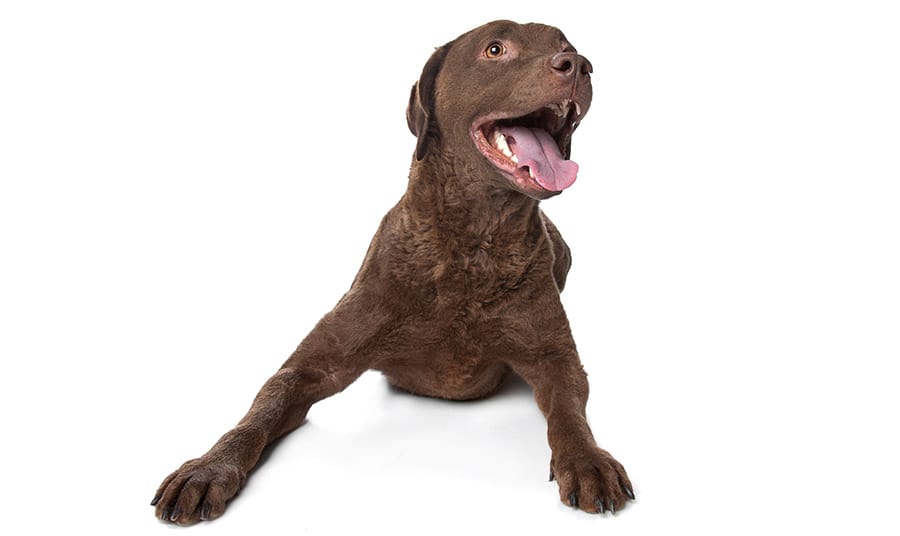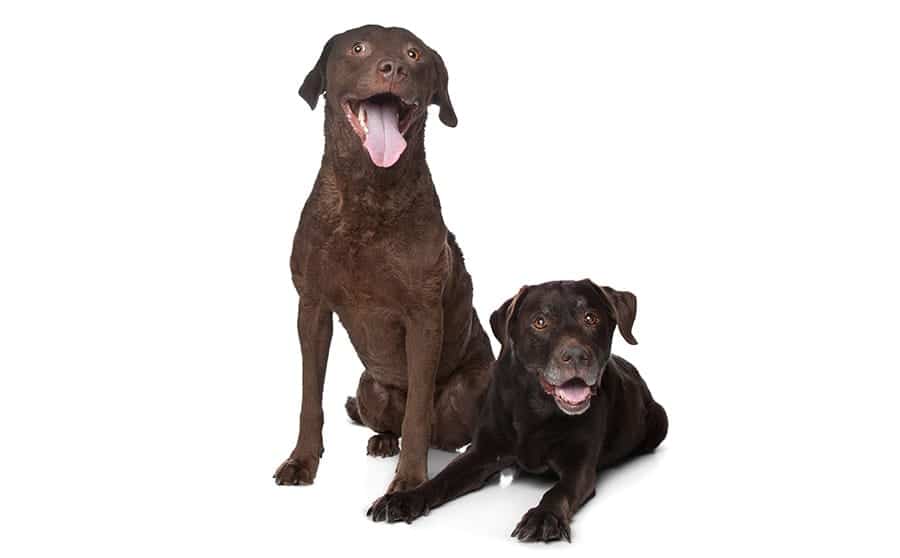Chesapeake Bay Retriever
Published: Last updated: by Kyle J. Larson
A strong, smart dog, the Chesapeake Bay Retriever exhibits all of the things that make retrievers so beloved. They’re loyal, happy and easy to train.
Average size and lifespan

Weight: 55-80lbs
Lifespan: 10 - 13 Years
Behavior
- Affection
- Kid-Friendly
- Stranger-Friendly
- Dog-Friendly
- Barking Amount
Care
- Grooming Difficulty
- Shedding Amount
- Easy to Train
- Can Be Alone
- Exercise Need
Environment
- Cold Tolerance
- Heat Tolerance
- Apartment-Friendly
Chesapeake Bay Retriever Information
Chesapeake pups stand out for their wavy coat, which is waterproof and a little oily. The color runs on the spectrum from tan to red to brown, complementing the breed’s yellow-amber eyes. Additionally, “Chessies” are natural athletes and make great hunting dogs.
History
The Chesapeake Bay Retriever is a sturdy and robust breed that hails from the eastern shores of the United States. With its dense, oily coat and muscular physique, the Chesapeake Bay Retriever is well-suited to life on the water, where it was originally bred to hunt waterfowl.
The breed’s history can be traced back to the early 19th century when settlers in the Chesapeake Bay region of Maryland and Virginia began breeding dogs to help them hunt ducks and geese. These early dogs were a mix of retrievers and other sporting breeds, and over time, they developed into the distinctive and resilient breed we know today.

Training and Temperament
The big difference between the Chesapeake and other retrievers is that this breed is more emotionally complex, with an exceptionally strong tie to their family and a highly perceptive nature.
Regarding training, the Chesapeake Bay Retriever is a highly intelligent and eager-to-please breed. They are known for their willingness to learn and their ability to adapt to a variety of environments and tasks. However, they can also be strong-willed and stubborn, so it is important to establish yourself as the pack leader early in training.
In terms of temperament, the Chesapeake Bay Retriever is generally a friendly and affectionate breed. They are good with children and other animals, and they make excellent family pets. However, they can be reserved with strangers and may require socialization to become more comfortable around new people.
As for grooming, the Chesapeake Bay Retriever’s dense, oily coat requires regular brushing to maintain its health and appearance. They shed heavily, so daily brushing is recommended during shedding season to keep their coat in good condition. They also require regular ear cleaning and nail trimming to prevent health issues.
Overall, the Chesapeake Bay Retriever is a versatile and intelligent breed that is well-suited to life on the water and in the home. With the right training and socialization, they can make a loyal and loving companion for any family.
All dogs have their own personality and unique training, causing them to differ slightly from these breed stats. However, please let us know if we made an error in the stats, we appreciate your help!
Breed FAQs
Can Chesapeake Bay Retrievers be apartment dogs?
The Chesapeake Bay Retriever needs room to run and play. This makes them difficult to keep in small spaces like an apartment.
Can Chesapeake Bay Retrievers be left alone?
While Chesapeake Bay Retrievers prefer to be around their owners, they can do fairly well when left alone if necessary.
Are Chesapeake Bay Retrievers good with kids?
Chesapeake Bay Retrievers can do fine with kids. They will require some monitoring and training to make sure they get along and react well to unpredictable behavior.
Are Chesapeake Bay Retrievers friendly with strangers?
Although Chesapeake Bay Retrievers can take a bit to warm up to a stranger, they are mostly friendly with others.
Do Chesapeake Bay Retrievers get along with other dogs?
Although Chesapeake Bay Retrievers will mostly get along with other dogs, they may have some issues. They can typically be dealt with by socializing them with other dogs.
Do Chesapeake Bay Retrievers bark a lot?
As far as dogs go, Chesapeake Bay Retrievers bark an average amount. You can expect them to bark to alert you, get your attention, or when there are strangers or other dogs.
Do Chesapeake Bay Retrievers shed a lot?
Chesapeake Bay Retrievers shed quite a bit. You'll need to brush them often to limit the hair on your floors and clothing.
Do Chesapeake Bay Retrievers need a lot of grooming?
Although Chesapeake Bay Retrievers require a medium amount of maintenance to keep their coats healthy. Simple tasks like brushing and bathing will suit this breed.
Do Chesapeake Bay Retrievers need a lot of exercise?
The Chesapeake Bay Retriever has a good amount of energy and will need to be exercised with some walks and play to keep them happy.
Are Chesapeake Bay Retrievers easy to train?
Typically, Chesapeake Bay Retrievers are easy to train. They enjoy the bonding process with their owner and are quick to learn.
Can Chesapeake Bay Retrievers handle cold weather?
Chesapeake Bay Retrievers do well in cold weather. You may need to protect their paws, but they'll do well in colder climates.
Can Chesapeake Bay Retrievers handle hot weather?
Chesapeake Bay Retrievers do well in hot climates and can stay out longer without overheating.
 Getting a New Dog?
Getting a New Dog?